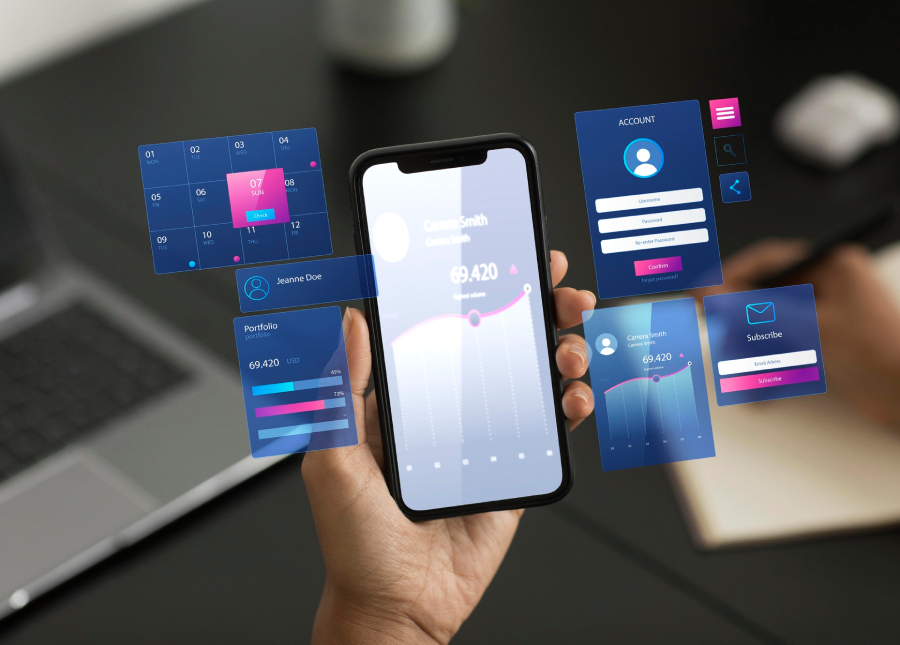Blogs

Mobile App Development: Key Features Every App Needs
In today’s fast-paced digital world, mobile apps have become integral to both business and daily life. The mobile app development market is growing rapidly, with millions of apps available in app stores. However, with so many apps competing for attention, ensuring that your app stands out is crucial.
To achieve success, it’s essential to implement the right features that enhance user experience, performance, and functionality. Moreover, this blog discusses the key features that every app needs in mobile app development. Consequently, these features help create intuitive, efficient, and enjoyable experiences for users.
User-Friendly Interface (UI) and Intuitive UX Design
The design and user experience of an app are, undoubtedly, the first things users notice. A clean, organized interface is essential for a positive experience. Here are key aspects of an effective UI/UX design:
- Simplified navigation: Moreover, easy-to-understand menus and clear calls-to-action (CTAs) guide users through the app seamlessly.
- Consistency: Additionally, consistent design elements, colors, and fonts improve both brand recognition and usability.
- Engaging visuals: Furthermore, quality visuals, icons, and animations enhance the aesthetic appeal and help keep users engaged.
A user-friendly interface and intuitive user experience, therefore, are essential features of mobile app development, as they encourage continued use and drive user satisfaction.
Speed and Performance Optimization
App speed plays a crucial role in user satisfaction. Slow or laggy apps often result in high bounce rates and user frustration. To ensure smooth performance:
- Optimize code: Use efficient programming practices and frameworks to enhance app speed.
- Reduce loading times: Compress images and minimize data usage to reduce the app’s load time.
- Test on multiple devices: Ensure the app runs smoothly on various devices, networks and operating systems.
A well-optimized app not only improves user experience but also contributes to better reviews and app store rankings.
Seamless Navigation and Clear Structure
Navigation should be seamless and intuitive. A clear structure helps users find what they need quickly. Key considerations include:
- Organized layout: Properly organize features and content so users can find them easily.
- Back and forward options: Allow users to move easily between screens.
- Search functionality: A powerful search option makes it easy for users to find specific content or features.
Effective navigation ensures that users can access all the app’s features without frustration, enhancing engagement and retention.
Mobile app development: Push Notifications
Push notifications are essential for keeping users informed and engaged. However, they must be used wisely to avoid annoying users. Key considerations include:
- Personalized notifications: Send tailored messages based on user preferences or behavior.
- Timely alerts: Use notifications to inform users about updates, offers or important events.
- User control: Allow users to control the types of notifications they receive.
Push notifications, when used effectively, can boost user engagement and retention, encouraging users to return to the app.
Mobile app development: Security Features
Security is a top priority in mobile app development. Users are becoming more aware of potential risks associated with using apps, so safeguarding their data is critical. Essential security features include:
- Data encryption: Ensure that user data is encrypted both during transmission and while stored.
- Authentication mechanisms: Implement multi-factor authentication or biometric security for enhanced protection.
- Privacy controls: Allow users to manage their data preferences and opt-in/opt-out of certain features.
Strong security features build trust with users, ensuring they feel confident in using your app and sharing their personal information.

Offline Mode Functionality
Many apps rely on an internet connection for full functionality. However, users may sometimes need to use apps while offline. Offering an offline mode is a great way to enhance user experience.
- Offline access to certain features: Provide access to critical features even when users have no internet connection.
- Data sync when online: Sync data and updates once the device reconnects to the internet.
Offline functionality ensures that users can still engage with the app, even in areas with limited or no connectivity.
Social Media Integration
Integrating social media functionality makes it easier for users to share content and engage with your app. Key benefits include:
- Social login: Allow users to log in using their social media accounts for a quicker and simpler registration process.
- Sharing content: Enable users to share app content on social media platforms, which also acts as free promotion for your app.
- Engagement with friends: Allow users to connect with friends or other users through social features within the app.
Social media integration helps expand the app’s reach and keeps users connected with friends, improving app retention.
Mobile app development: Analytics and Insights
Incorporating analytics into your app helps you track user behavior and understand how users interact with the app. Key features include:
- User tracking: Moreover, monitor how users interact with your app to identify areas for improvement.
- Behavior analysis: Additionally, use insights to customize features, improve user retention and increase conversions.
- A/B testing: Furthermore, test different versions of features or interfaces to determine what works best for users.
Thus, analytics provide valuable data to refine your app’s functionality and optimize user engagement and retention.
Regular Updates and Bug Fixes
To keep users satisfied, regularly update your app with new features, bug fixes, and performance improvements. Key strategies include:
- Frequent updates: Moreover, offer new features or improvements to keep users engaged and attract new users.
- Bug fixes: Additionally, regularly fix bugs and performance issues to maintain a smooth experience.
- User feedback: Furthermore, incorporate feedback from users to identify and resolve pain points.
Therefore, Regular updates and maintenance, ensure your app remains relevant and functional, helping to maintain a loyal user base.
Mobile app development: Cross-Platform Compatibility
With various devices and operating systems in use, ensuring your app works on multiple platforms is crucial. Key features include:
- Cross-platform frameworks: Use frameworks like Flutter or React Native to build apps that work seamlessly on both iOS and Android.
- Consistent design: Ensure the app’s design and functionality remain consistent across devices.
- Testing across platforms: Regularly test the app on various devices to ensure compatibility.
Cross-platform compatibility expands your app’s reach and ensures that all users have a consistent experience, regardless of the device they use.
Conclusion
Mobile app development requires a strategic approach to create an app that users truly love. Moreover, incorporating the right features is essential for ensuring that your app stands out in a competitive market. By focusing on user experience, performance, security, and innovative functionalities, you can effectively build an app that meets the needs of your audience.
Additionally, investing in these key features will help ensure that your mobile app delivers an excellent user experience, engages users, and ultimately achieves long-term success.



